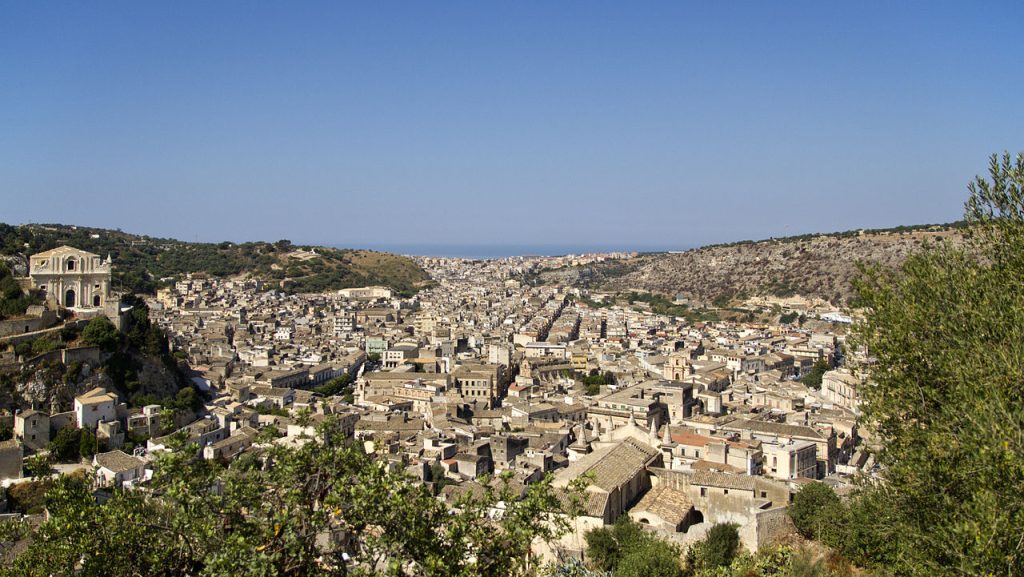Modica has the actual plan, thanks to the human modification during the time. Many homes which are in old city part and all leaning on each other, are often the extension of old caverns, lived since the prehistoric era. In fact, we can count 700 caverns which were lived or which were absorbed in new constructions. Very interesting in the Modica historical centre, is the necropolis Quartiriccio, with many tombs included in the rock and dated back to 2200 b. C. The urban planning, laid down between the two valleys and overhead hills, is full of little homes, little streets, long staircases which remind the medieval city centre map, all grown up on Pizzo hill in which, on the top, there was the Castle. Modica is an unexpected surprise…it is like something unreal inside the prism dream, like a phantasmagorical amount of fairy tales which is made up of homes in layer!
Normally all Churches in Modica haven’t square, but long staircases modelled on hill slopes. Modica area is full of Sicilian Baroque style after the heartquake in 1693. Another connotative element in all Modica field are the “muro a secco”, walls which delimit the plots full of carob trees, main Italian producer of it. The Muro a secco history is originally through a little land owners class that from the XVI century started to divide the huge feud, la Contea di Modica, which correspond to the whole Ragusa district.
SAINT GEORGE CATHEDRAL
 It is often indicated like symbol of Sicilian Baroque style. This church is word heritage UNESCO and it is the final result of the reconstruction after the 1542, 1613 and 1693 heartquakes.The majestic tower front, 62 m high, was started in building in 1702 and completed in 1842, by putting the iron spire.
It is often indicated like symbol of Sicilian Baroque style. This church is word heritage UNESCO and it is the final result of the reconstruction after the 1542, 1613 and 1693 heartquakes.The majestic tower front, 62 m high, was started in building in 1702 and completed in 1842, by putting the iron spire.
The actual front – very similar to the Dresna Katholische Hofkirche – was realized by destroying maybe the earlier XVII century structure, about what, we haven’t any documents.
The dome is high 36 metres. The scenographic staircase has 164 steps: the part up to the street was projected in 1814 by the Jesuit Francesco Di Marco and it was completed in 1818. It accompanies till the five church gates which introduce the inside five aisles. The cathedral has a Latin cross map, three apsis and a transept. The staircase under the Corso San Giorgio was projected in 1874 by the architect Alessandro Cappellani Judica and it was completed in 1880. The frontal perspective is enriched by a pensile garden in different levels, called Orto del Piombo which remember Trinità dei Monti in Roma.
The church has inside five aisles, with 22 columns with Corinthian capitals. The cathedral is consecrated to Saint George and Hippolite martyrs and among the aisles, we can admire: the monumental organ with 4 keyboards, 80 ranges and 3000 pipes, nowadays active and made between 1885 and 1888 by Casimiro Allieri from Bergamo; L’Assunta made by late mannerist Filippo Paladini (1610), a painting of Toscana school; La Natività by the painting Carlo Cane (1615-1688), a middle XVII century naïf painting made over a wood table; the Cicalesius painting Martirio di Sant’Ippolito (1671), a marble statue from the Gagini school; Madonna della Neve (1511) of Bartolomeo Berrettaro and Giuliano Mancino; the main altar polyptych, made up of 10 tables, which was attributed to Girolamo Alibrandi, but the XX century researchers ascribed definitely the work to Bernardino Nigro (1573); the altarpieces represent the Holy Family scenes and the Jesus life, from the Nativity till the Resurrection and the Assumption, in addition to two classical icons of the rider Saint, Saint George whose beats the dragon and Saint Martin who divides his own cape with Jesus, who shows him by acting as a poor beggar.
SAINT PETER CATHEDRAL

As the XVII century historian Placido Carrafa certifies, it was built from 1305 till 1350. Two century after the Royal Decree of Charles III of Borbone (1797), it was raised up like collegiate church on behalf of Clement VIII the 2nd January 1597 and then, after several debates, it was declared Chiesa Madre like Saint George cathedral, the official Count church. This church is also UNESCO world heritage.
SAINT JOHN EVANGELIST CHURCH
This church has a front which was make again in 1839 and then it was completed between 1893 and 1901. The cult occurs there since 1150 (Pope Eugenio III seal). In March 1217, a document declares that both the Saint John Evangelist church and Saint George one, were under the protection of Mileto Church in Calabria.
CARMINE CHURCH
The Santa Maria del Carmine church, named “del Carmine” (XIV-XV century) is one of the few monuments which resisted to the 1693 heartquake. In fact, the façade is enriched by a XIV century gate, declared National Monument during the XX century. On the top of it, we can find a Franciscan rose window with 12 rays in Chiaramonte Late Gothic style.
CARMINE MONASTERY
It was erected between the end of XIV century and the half XV century, just to host the Carmelite friar established in Sicily several years ago. The convent has 23 cells and it was restructured, firstly after the heartquake, by amplifying in raising and then when it was confiscated by the Regno d’Italia in 1861 just to do a Carabinieri Military base. In this period, the opposite vegetable garden was placed by a public square, dedicated to Giacomo Matteotti. The front was done again in liberty neo renaissance style. Around 2000, when the Carabinieri Military base moved in another place, they were done important restoration works that rediscovered its medieval structure with a XIV century cobblestones floor, the gothic ogee arch which link a room with another and the XIV century Svevo Chiaramonte little window style. These discoveries were declared the 24th and 25th March 2012, during the XX Fondo Ambientale Italiano (FAI) day.
SAINT DOMINIK CHURCH, EX MONASTERY AND CRYPT
Saint Dominik church. Named of the Rosario (1678) present a survival front from the famous heartquake in 1693.
The original church structure with the annexed to the Dominican monastery dated in 1461. The sacral place is full of XVI century paintings, an internal chapel just for the Dominican prayer and decorated with wall paintings and plasters. Since 1869, is the official Municipal Palace. In lobby, we can find an interesting subterranean crypt (XVII century). It was discovered by Giovanni Modica Scala in middle XX century. Here we have bone relics and frescos trace. The monastery was the legal Inquisition tribunal office for the Syracuse diocese.
DE LEVA PORTAL
The national Monument De Leva Portal, of early IV century, is an elegant gothic example style which will influence the whole IV century in Sicily. Is one of the most wonderful portal in Modica, with a big ogee arches in three orders, made up of zig zag geometrical decorations and acanto leafs which complete the arabesque embroideries. Probably it was the gate of a church consecrate to Saint Philip and Jack, as inspires a little circular window on the top of the portal and which would contain a rose window, typical church decoration. After the heartquake of 1693 became the private chapel of De Leva family palace. The door of De Leva home is the last rest of a little Gothic church which doesn’t exist anymore…the two big splendid ogee windows of Palermo Cathedral in Modica, as written by the writer Salvatore Minardo in 1952.
MADONNA DELLE GRAZIE SANCTUARY
It is a church that arises in the low area of Modica. It was erected after the discovery of a small slate wooden board, the 4th May 1615, illustrating the Virgin and the Child in her arms; the history tell us that this wooden board was on fire for three days, inside a bramble brush, without any consume and for this reason, the Modica people declared the miracle and established to build the church. The works on it were gestured by the architect Vincenzo Mirabella and they started suddenly, but they were interrupted in 1624, when the architect died. The lateral gate is from the early XVII century, and it is in late renaissance style under the tympanum. The bell tower, on left side of the main front of the church, made again after the heartquake of 1693, is in late baroque style and it has protruding and strong binary columns, very similar to the Saint George Cathedral.
The Madonna delle Grazie was declared The main Modica protector, with episcopal decree dated 3rd August 1627, as requested by the municipal assembly in Copia Cosili Civitatis Moticae of 1626 which is in Carmelite general archive in Rome. In apsis vault, there is a painting illustrating the Holy Mary dominating the city and in which we can find the write: Ecce Mothuca Mater Tua.
In January 2015 the sanctuary became minor Basilica.
MONUMENTS AND POINT OF INTEREST: CIVIL ARCHITECTURE
POLARA PALACE
In Saint George cathedral left side, we can admire the XVIII century Polara Palace that has a fronton with family emblem of the Polar Star. It is a late baroque structure, introduced by an elegant perron. The front, linked to the monumental staircase and Saint George Cathedral, manages the low area of the city centre in Modica, carrying us till the panoramic viewpoint, called Pizzo.
PALAZZO DEGLI STUDI
In reality, it was the Jesuit Monastery (1610-1630) and they realized the college for aristocrat descendants in Modica. The building was born for will power of countess Vittoria Colonna de Cabrera, promoter for Jesuit coming in Modica.
Since 1630, it was, firstly Communal Gymnasium in 1862, Royal technical Institute “Archimede” in 1866 and since 1878 it host the Liceo Classico, entitled to the scientist and philosopher Tommaso Campailla.
GARIBALDI THEATRE
It was built the first time between the 1815 and the 1820, by linking a warehouse with an aristocrat home and it was called Real Teatro Ferdinandeo just to do justice to the actual regnant. It had 2 lines of 24 daises and an orchestra. In 1844 it was amplified thanks to the engineer Salvatore Riga, redoubling the orchestra, rising up a third line in stage, adding the gallery, by reproducing the lyrical style of Italian theatre diffused in Sicilian cities. After the Italy Unity, the theatre was untitled to Garibaldi. The front is in liberty style and it has two floors decorated with a balustrade which has sculptured patch with musical instruments. Above it, there is a clock, supported by two male personalities, with an eagle, the Contea di Modica symbol. It was inaugurated in 1857 with the Giuseppe Verdi Traviata. After renovation works, it was definitely opened in 2004. In December 2016, they started the rehabilitation works about the orchestral pit, just to host musical exhibitions.
MONUMENTS AND POINT OF INTEREST: MILITARY ARCHITECTURES
The Castle, erected on the top of a cliff, represented for many centuries the political and administrative power place of Contea di Modica. The Castle, or what’s left, was born like fortification above a rocked promontory, quite difficult to assault, because it has two sides on three edified on a cliff.
THE CLOCK TURRET
In 1725, above the post heartquake medieval fire tower rests of Conti Castle, it was putted a mechanical counterbalanced clock, actually in a good status, regulated and controlled every 24 hours. The mechanical gears, were daily cared and regulated by a communal employer. The inside turret – made up of big metallic springs, weights and counterbalances, big ropes and chains – is available for visits only in particular circumstances. From the balustrade we can admire an unusual historical centre landscape towards the low area of the city. It was always considered the symbol of the Modica ancient aristocrat and UNESCO heritage.
SALVATORE QUASIMODO HOME
The Salvatore Quasimodo native home is the place where the poet was born the 20th august 1901. He obtained the Literature Nobel Prize the 10th December 1959. He lived there only his first 5 days. The home became a museum available for visits and it contains a wrought-iron bed, a kneeling-stool, a bedside and other XX century pieces of furniture; furthermore, we can find an old Olivetti typewriter, a desk, a cd collection, a bookcase with books coming from one of his study room in Milan and sold by his son Alessandro to the Sicilian Regional Department of Cultural assets in 1996, with other objects catalogued. The recorded poet voice follows the touristic home tour, by playing his poems. During the tour, we can listen his personal speech “Il Politico ed il Poeta” in Stockholm, during the Nobel Ceremony.
THE SAINT NICHOLAS LOWER ROCKY CHURCH
It is an artificial cave, dated back between XII and XVI century, full of wonderful frescos, made in nude rock. The church is in late Byzantine style, defined by researchers an unicum in medieval Sicily style. The main fresco represents a spectacular Almighty Christ, placed at the centre of the apsis. It illustrates a blessing Christ inside an almond and seated on a throne between two couple of Angels. On right apsis side, we can find a baptismal basin, excavated in rock, used for oriental baptism. Recently, new archaeological site brought to light several crypts and tombs.
CAVA ISPICA
Cava Ispica, named Spaccaforno till 1936, gathers in 13 Km length, several testimonies about different ages: from the Bronze age little Sicilian caves in furnace shape, till the later Roman empire Christian catacombs (IV-V century d.C.); from the “Grotta dei Santi” rocky frescos, till the little Byzantine S. Pancrati church ruins. The Larderia catacomb is a remarkable hypogeum cemetery, that in 500 m2 enclosed more then 464 tombs, divided in three subterranean galleries, among them, the main gallery is 30 metres length. Cava Ispica is a very city in rock, where we can find both caves lived by human and domestic animals, warehouse caves and place of worship with altars and frescos in nude rock. Finally, there are many funeral caves, hidden by flora or protected because of the difficulties in entrance.
In different areas, it is deep more then 100 metres and large more then 500 metres. It has a luxuriant flora and for this aim, Cava Ispica has an importance also from the naturalistic side.
Along the valley, we can find many natural caves, very difficult to reach.
The Sicano Castle with five floors is a very historical and architectural interesting built, because of its structure, fully builtin calcareous rock which plummets till 30 metres. Maybe it was the Prince dwelling.
CAVA LAZZARO
It represents one of the most important archaeological place about the Sicilian Palaeolithic. There we can find oven and anticella caves, religious caves also full of pillars and columns. Very relevant is the Orsi Tomb (the name was putted by the archaeologist which discovered it), maybe reserved for an important person which is adorned by false columns and geometric symbols. In Cava Lazzaro were found amygdala utensils, Castellucci culture crockeries, items from XXII-XV century b. C. (Castelluccio facies, the first Bronze Age), all preserved in Modica Civic Museum.
It was also found a Neanderthal cranium, kept in Ethnographical Museum L. Pigorini in Rome.
CAVA DEI SERVI
Cava dei Servi has a particular beauty and it has this name because in the past was often visited by Servi di Dio.
It interchange cliffs with flat areas and deep canyon, flooded from the creek. There, we can admire a wood full of holm oaks, with areas of scrublands, timing with bushes and small shrub, like the thyme. The initial area of Cava dei Servi, which is a forestry park is very wide and easy to access.
Along the cave flows the Tellesimo creek, a Tellaro affluent, which shapes the Gorgo della campagna, a little lake in circle contour. It borns in Contrada Bellocozzo, inside Cava dei Servi and it ends in 15 Km far, by flowing up in river Tellaro, in Noto area. Its riverbed has cliff areas, full of caves and, at the end it becomes narrow and contorted, by maintaining a whole ecosystem.
It was lived since prehistorically age. In fact, in Cozzo Croce zone, we can find a necropolis from Bronze Age, made up of two funeral monuments, the Dolmen, realized with big slab inserted in ground-level and placed in a rounded way.

